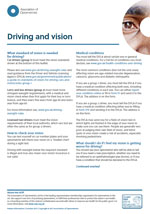Driving and vision
What standard of vision is needed for driving?
What standard of vision is needed for driving?
Car drivers
Car drivers (group 1) must meet the vision standards shown below.
Please also see the government website for driving eyesight rules and read guidance from the Driver and Vehicle Licensing Agency (DVLA).
Lorry and bus drivers
Lorry and bus drivers (group 2) must meet more stringent eyesight requirements, with a medical and vision check when they first apply for their bus or lorry licence, and then every five years from age 45 and every year from age 65.
For more information see the government website for driving eyesight rules.
Licensed taxi drivers
Licensed taxi drivers must meet the vision requirements of their local authority, which vary but are often the same as for group 2 drivers.
How to check your vision
Although we believe that a vision-testing programme should be introduced, which drivers must take before they apply for a licence, you can test yourself against the current standard by reading (with glasses or contact lenses, if necessary) a car number plate made after 1 September 2001 from 20 metres. You should check this yourself regularly. Your optometrist will check your vision on a Snellen chart during a sight test.
Driving with eyesight below the required standard is illegal and may also mean your motor insurance is not valid.
Medical conditions
You must tell the DVLA about certain eye or general medical conditions. For a full list of conditions you must declare, see the government website.
The most common conditions (but not the only ones) affecting vision are age-related macular degeneration, cataracts, glaucoma and diabetic retinopathy.
If you are a group 1 driver, you must tell the DVLA if you have a medical condition affecting both eyes, including different conditions in each eye. You can either report your condition online or fill in form V1 and send it to the DVLA. The address is on the form.
If you are a group 2 driver, you must tell the DVLA if you have a medical condition affecting either eye by filling in form V1V and sending it to the DVLA. The address is on the form.
The DVLA may send you for a field of vision test in which lights are flashed in the edge of your vision to make sure you can see them. People are generally very poor at judging their own field of vision, and blind spots in your vision create a risk of accidents, especially involving pedestrians.
What should I do if I feel my vision is getting worse for driving?
You should see your optometrist who will be able to tell you if you need a new prescription, whether you need to be referred to an ophthalmologist (eye doctor), or if you have a condition that should be declared to the DVLA.
Optometrist form for car drivers (group 1)
The following form is to be completed by the examining optometrist.
Resources for your practice
 Download our patient leaflet on Driving and vision standards.
Download our patient leaflet on Driving and vision standards.

